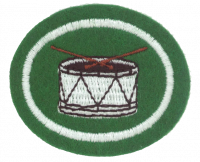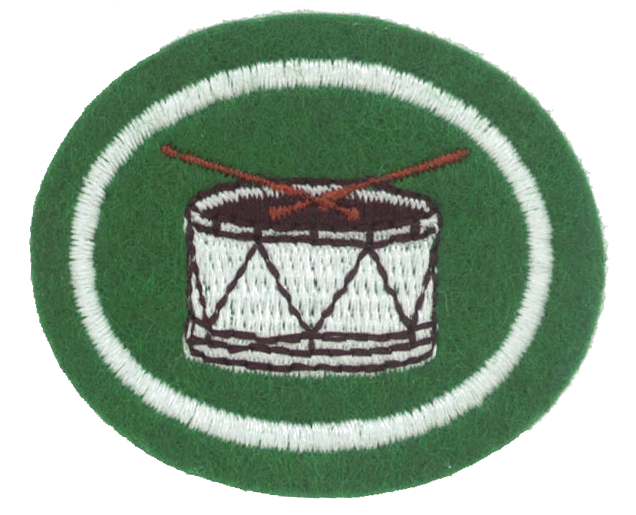Difference between revisions of "AY Honors/Drumming & Percussion/Requirements"
Jomegat bot (talk | contribs) (Bot: Automated import of articles *** existing text overwritten ***) |
m (- Category of Honor Requirements) |
||
| (8 intermediate revisions by 2 users not shown) | |||
| Line 1: | Line 1: | ||
| − | + | {{HonorSubpage}} | |
| − | |||
| − | |||
| − | + | <section begin=Body /> | |
| − | |||
| − | <b> | + | <b>1. <section begin=req1 /><noinclude><translate><!--T:1--> |
| − | <section end= | + | </noinclude>Write a one page paper demonstrating your knowledge of how a drum corps can be used to minister within your: |
| + | :a. local church | ||
| + | :b. community | ||
| + | <noinclude></translate></noinclude><section end=req1 /></b> | ||
| − | <b> | + | <b>2. <section begin=req2 /><noinclude><translate><!--T:2--> |
| − | <section end= | + | </noinclude>What are the four families of rudiments? |
| + | <noinclude></translate></noinclude><section end=req2 /></b> | ||
| − | <b> | + | <b>3. <section begin=req3 /><noinclude><translate><!--T:3--> |
| − | <section end= | + | </noinclude>Be able to name five rudiments from each of the four families of rudiments. |
| + | <noinclude></translate></noinclude><section end=req3 /></b> | ||
| − | <b> | + | <b>4. <section begin=req4 /><noinclude><translate><!--T:4--> |
| − | <section end= | + | </noinclude>Demonstrate ability to keep in step with the drum corps by taking part in at least one outreach program. (ex. Pathfinder Day, Conference or Local church sponsored event) |
| + | <noinclude></translate></noinclude><section end=req4 /></b> | ||
| − | <b> | + | <b>5. <section begin=req5 /><noinclude><translate><!--T:5--> |
| − | <section end= | + | </noinclude>What is the difference between drum carriers and drum straps? Demonstrate with drum equipment in a formation. |
| + | <noinclude></translate></noinclude><section end=req5 /></b> | ||
| − | <b> | + | <b>6. <section begin=req6 /><noinclude><translate><!--T:6--> |
| − | <section end= | + | </noinclude>What are the seven essential rudiments? Why are they essential? |
| + | <noinclude></translate></noinclude><section end=req6 /></b> | ||
| − | <b> | + | <b>7. <section begin=req7 /><noinclude><translate><!--T:7--> |
| − | <section end= | + | </noinclude>What is the difference between playing open vs. closed? |
| + | <noinclude></translate></noinclude><section end=req7 /></b> | ||
| − | <b> | + | <b>8. <section begin=req8 /><noinclude><translate><!--T:8--> |
| − | <section end= | + | </noinclude>Using the open/closed method, demonstrate your knowledge of the seven essential rudiments. Execute: Open to Closed to Open |
| + | <noinclude></translate></noinclude><section end=req8 /></b> | ||
| − | <b> | + | <section begin=challenge /> |
| − | <section end= | + | <b>9. <section begin=req9 /><noinclude><translate><!--T:9--> |
| + | </noinclude>What is the difference between traditional style and matched style stick holding? Demonstrate each style by playing a sequence consisting of no less than three rudiments. | ||
| + | <noinclude></translate></noinclude><section end=req9 /></b> | ||
| + | <section end=challenge /> | ||
| − | <b> | + | <b>10. <section begin=req10 /><noinclude><translate><!--T:10--> |
| − | <section end= | + | </noinclude>What is the difference between drumsticks used for a drum corps and those used for a percussion drum set? |
| + | <noinclude></translate></noinclude><section end=req10 /></b> | ||
| − | <b> | + | <b>11. <section begin=req11 /><noinclude><translate><!--T:11--> |
| − | <section end= | + | </noinclude>What are the sections that make up a drum corps? |
| + | <noinclude></translate></noinclude><section end=req11 /></b> | ||
| − | <b> | + | <b>12. <section begin=req12 /><noinclude><translate><!--T:12--> |
| − | <section end= | + | </noinclude>Based on the previous question, what purpose does each section serve? |
| + | <noinclude></translate></noinclude><section end=req12 /></b> | ||
| − | <b> | + | <b>13. <section begin=req13 /><noinclude><translate><!--T:13--> |
| − | <section end= | + | </noinclude>Show the various types of protective devices used to secure drum corps equipment. |
| + | <noinclude></translate></noinclude><section end=req13 /></b> | ||
| − | <b> | + | <b>14. <section begin=req14 /><noinclude><translate><!--T:14--> |
| − | <section end= | + | </noinclude>What are the various types and sizes of drumsticks used for a drum corps? |
| + | <noinclude></translate></noinclude><section end=req14 /></b> | ||
| − | + | <b>15. <section begin=req15 /><noinclude><translate><!--T:15--> | |
| − | + | </noinclude>Know what tools and equipment used for drum practice sessions. | |
| + | <noinclude></translate></noinclude><section end=req15 /></b> | ||
| + | <section end=Body /> | ||
Latest revision as of 22:07, 20 July 2022
1. Write a one page paper demonstrating your knowledge of how a drum corps can be used to minister within your:
- a. local church
- b. community
2. What are the four families of rudiments?
3. Be able to name five rudiments from each of the four families of rudiments.
4. Demonstrate ability to keep in step with the drum corps by taking part in at least one outreach program. (ex. Pathfinder Day, Conference or Local church sponsored event)
5. What is the difference between drum carriers and drum straps? Demonstrate with drum equipment in a formation.
6. What are the seven essential rudiments? Why are they essential?
7. What is the difference between playing open vs. closed?
8. Using the open/closed method, demonstrate your knowledge of the seven essential rudiments. Execute: Open to Closed to Open
9. What is the difference between traditional style and matched style stick holding? Demonstrate each style by playing a sequence consisting of no less than three rudiments.
10. What is the difference between drumsticks used for a drum corps and those used for a percussion drum set?
11. What are the sections that make up a drum corps?
12. Based on the previous question, what purpose does each section serve?
13. Show the various types of protective devices used to secure drum corps equipment.
14. What are the various types and sizes of drumsticks used for a drum corps?
15. Know what tools and equipment used for drum practice sessions.


